Abstract
The intravenous injection of 15 micrograms capsaicin produced an increase in the temperature of tail skin and paw pad and a fall in the colon temperature in conscious rats. These reactions reflect increased heat dissipation. The increase in skin temperature induced by intravenous capsaicin was absent when the function of small diameter primary afferent neurones was impaired by treatment of the rats with capsaicin as neonates. Thus it appears that intravenous capsaicin triggered the thermoregulatory response predominantly by stimulation of peripheral heat receptors. By means of local application of capsaicin to the nerves of the hind leg and by their chronic denervation, by treatment with phenoxybenzamine and guanethidine, evidence was obtained that reflex withdrawal of sympathetic vasoconstrictor tone mediates the heat loss reaction intravenous capsaicin.
Full text
PDF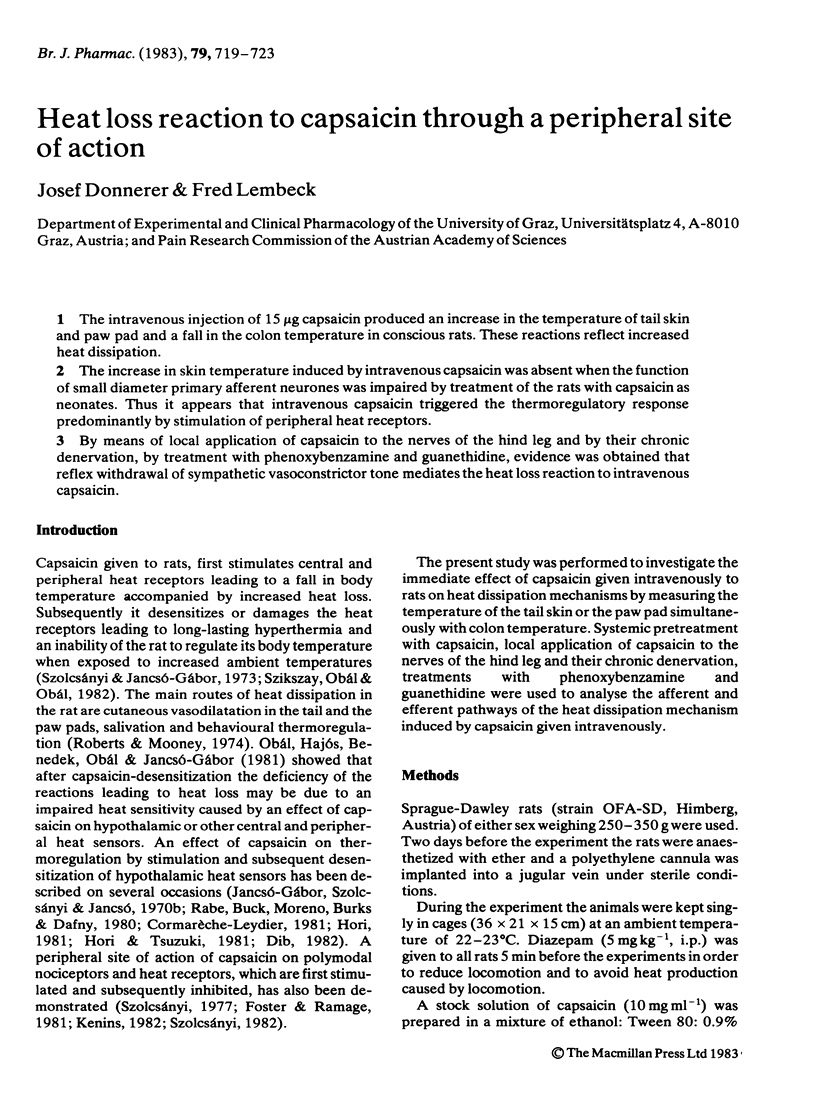
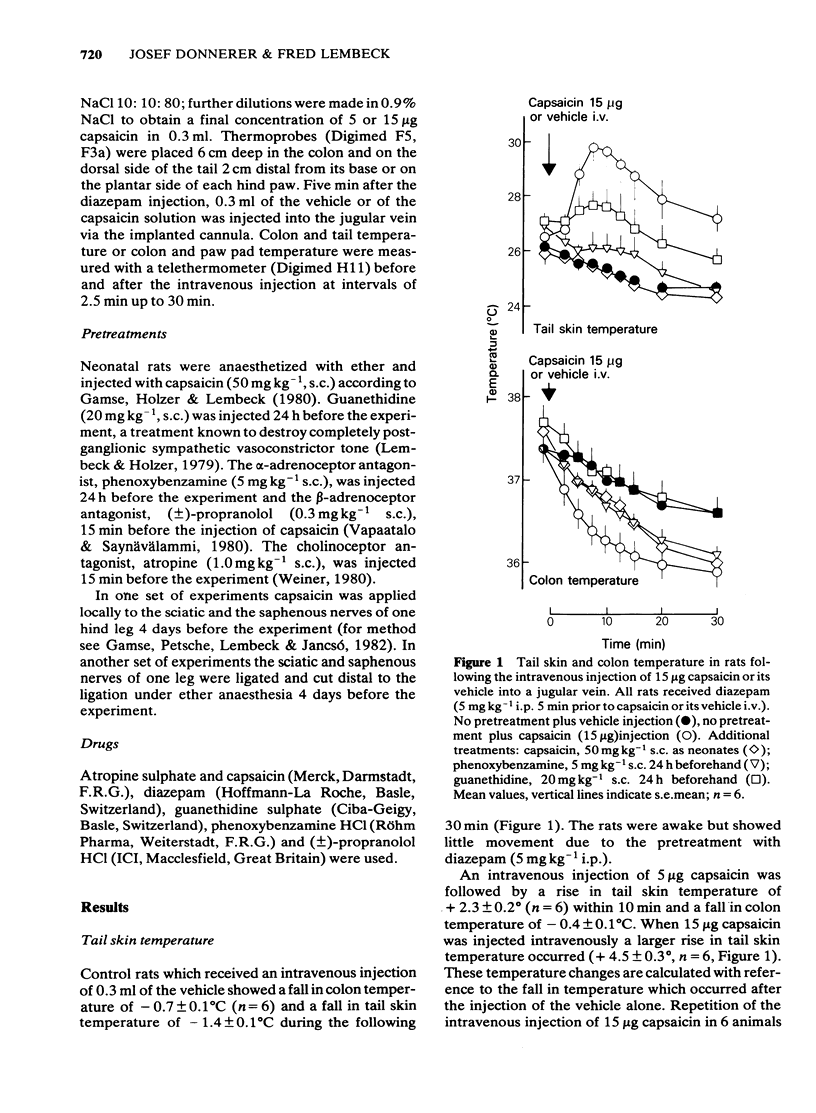
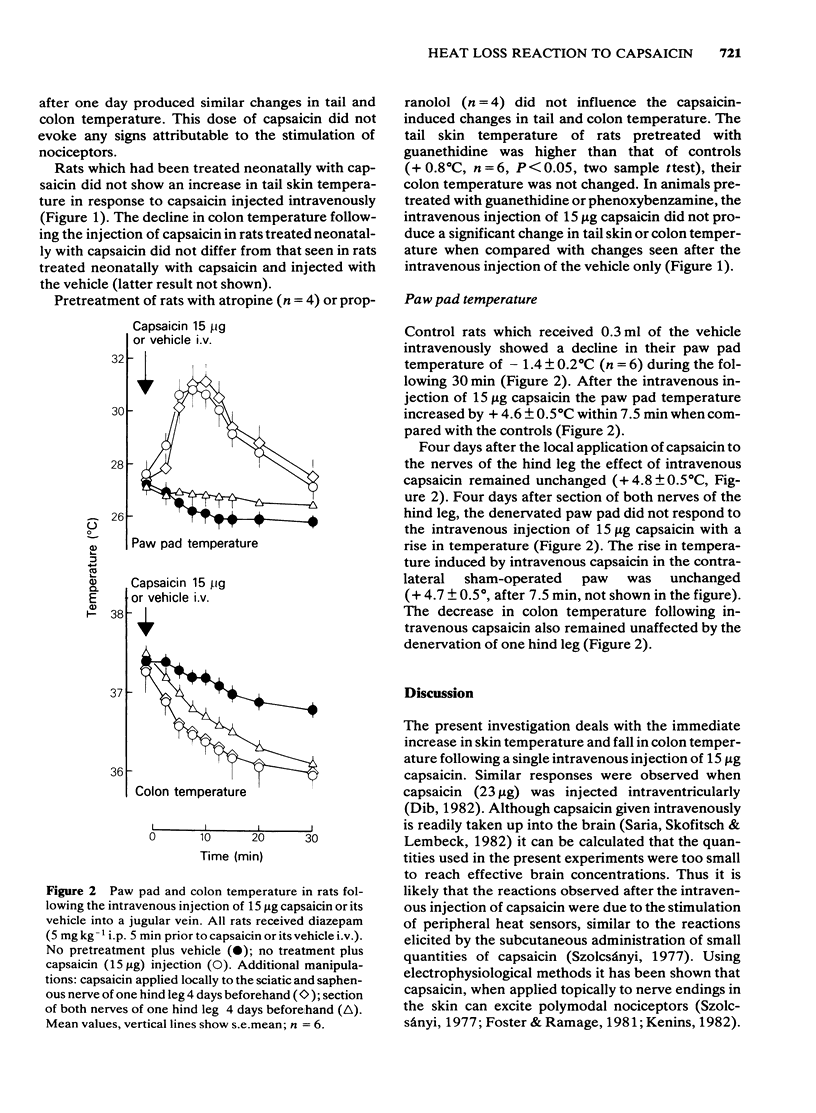
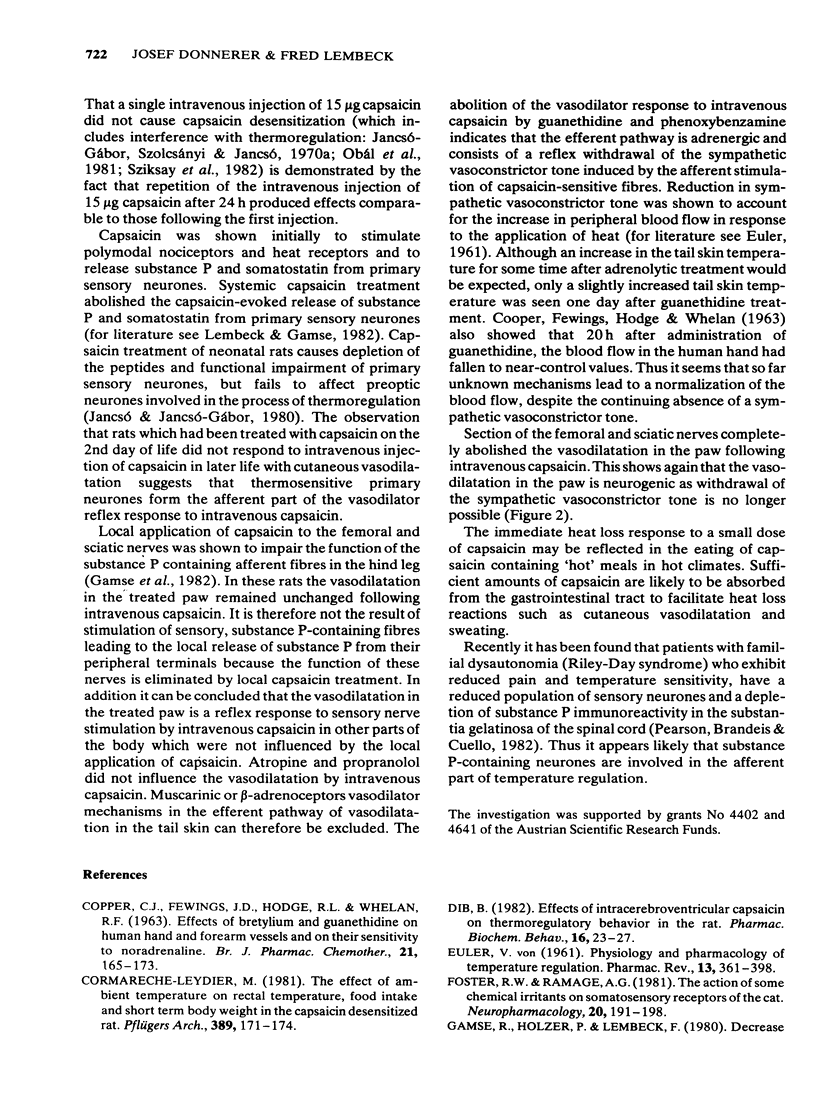
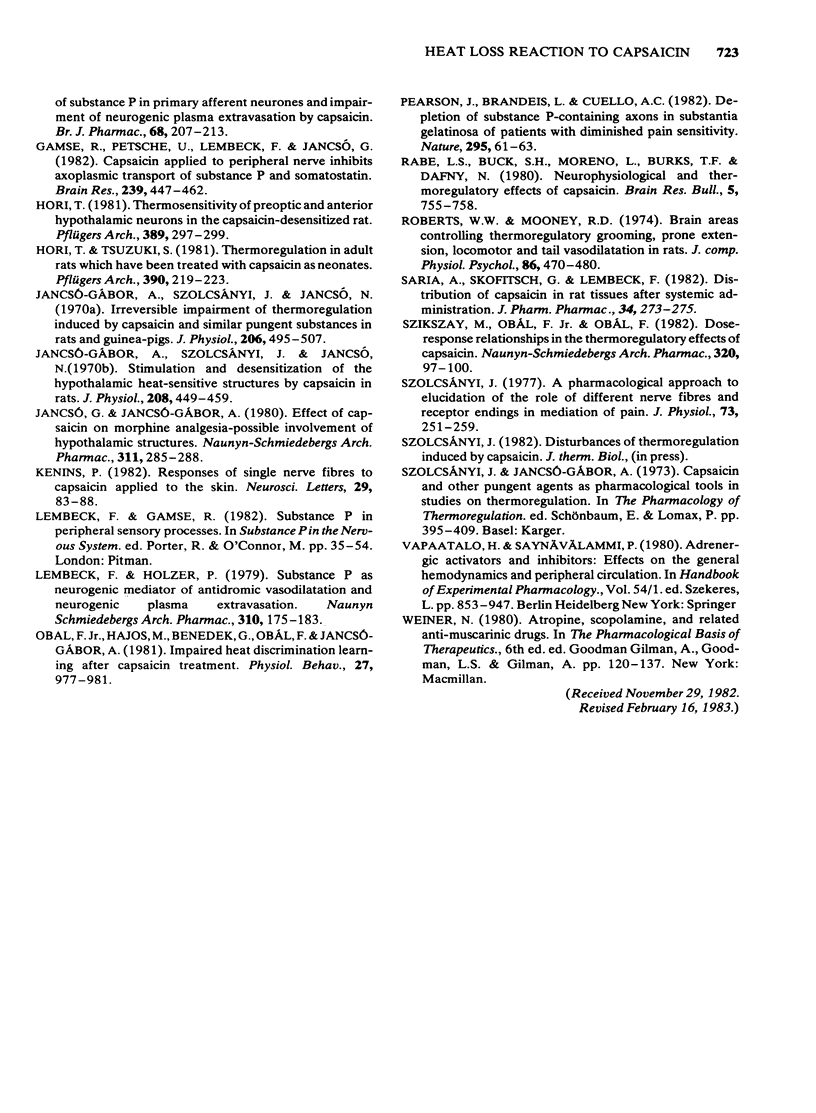
Selected References
These references are in PubMed. This may not be the complete list of references from this article.
- COOPER C. J., FEWINGS J. D., HODGE R. L., WHELAN R. F. EFFECTS OF BRETYLIUM AND GUANETHIDINE ON HUMAN HAND AND FOREARM VESSELS AND ON THEIR SENSITIVITY TO NORADRENALINE. Br J Pharmacol Chemother. 1963 Aug;21:165–173. doi: 10.1111/j.1476-5381.1963.tb01512.x. [DOI] [PMC free article] [PubMed] [Google Scholar]
- Cormarèche-Leydier M. The effect of ambient temperature on rectal temperature, food intake and short term body weight in the capsaicin desensitized rat. Pflugers Arch. 1981 Jan;389(2):171–174. doi: 10.1007/BF00582109. [DOI] [PubMed] [Google Scholar]
- Dib B. Effects of intracerebroventricular capsaicin on thermoregulatory behavior in the rat. Pharmacol Biochem Behav. 1982 Jan;16(1):23–27. doi: 10.1016/0091-3057(82)90007-7. [DOI] [PubMed] [Google Scholar]
- Foster R. W., Ramage A. G. The action of some chemical irritants on somatosensory receptors of the cat. Neuropharmacology. 1981 Feb;20(2):191–198. doi: 10.1016/0028-3908(81)90203-3. [DOI] [PubMed] [Google Scholar]
- Gamse R., Holzer P., Lembeck F. Decrease of substance P in primary afferent neurones and impairment of neurogenic plasma extravasation by capsaicin. Br J Pharmacol. 1980 Feb;68(2):207–213. doi: 10.1111/j.1476-5381.1980.tb10409.x. [DOI] [PMC free article] [PubMed] [Google Scholar]
- Gamse R., Petsche U., Lembeck F., Jancsò G. Capsaicin applied to peripheral nerve inhibits axoplasmic transport of substance P and somatostatin. Brain Res. 1982 May 13;239(2):447–462. doi: 10.1016/0006-8993(82)90521-2. [DOI] [PubMed] [Google Scholar]
- Hori T. Thermosensitivity of preoptic and anterior hypothalamic neurons in the capsaicin-desensitized rat. Pflugers Arch. 1981 Mar;389(3):297–299. doi: 10.1007/BF00584793. [DOI] [PubMed] [Google Scholar]
- Hori T., Tsuzuki S. Thermoregulation in adult rats which have been treated with capsaicin as neonates. Pflugers Arch. 1981 Jun;390(3):219–223. doi: 10.1007/BF00658265. [DOI] [PubMed] [Google Scholar]
- Jancsó-Gábor A., Szolcsányi J., Jancsó N. Irreversible impairment of thermoregulation induced by capsaicin and similar pungent substances in rats and guinea-pigs. J Physiol. 1970 Mar;206(3):495–507. doi: 10.1113/jphysiol.1970.sp009027. [DOI] [PMC free article] [PubMed] [Google Scholar]
- Jancsó-Gábor A., Szolcsányi J., Jancsó N. Stimulation and desensitization of the hypothalamic heat-sensitive structures by capsaicin in rats. J Physiol. 1970 Jun;208(2):449–459. doi: 10.1113/jphysiol.1970.sp009130. [DOI] [PMC free article] [PubMed] [Google Scholar]
- Jancsó G., Jancsó-Gábor A. Effect of capsaicin on morphine analgesia--possible involvement of hypothalamic structures. Naunyn Schmiedebergs Arch Pharmacol. 1980 Apr;311(3):285–288. doi: 10.1007/BF00569408. [DOI] [PubMed] [Google Scholar]
- Kenins P. Responses of single nerve fibres to capsaicin applied to the skin. Neurosci Lett. 1982 Mar 17;29(1):83–88. doi: 10.1016/0304-3940(82)90369-x. [DOI] [PubMed] [Google Scholar]
- Lembeck F., Gamse R. Substance P in peripheral sensory processes. Ciba Found Symp. 1982;(91):35–54. doi: 10.1002/9780470720738.ch4. [DOI] [PubMed] [Google Scholar]
- Lembeck F., Holzer P. Substance P as neurogenic mediator of antidromic vasodilation and neurogenic plasma extravasation. Naunyn Schmiedebergs Arch Pharmacol. 1979 Dec;310(2):175–183. doi: 10.1007/BF00500282. [DOI] [PubMed] [Google Scholar]
- Obál F., Jr, Hajós M., Benedek G., Obál F., Jancsó-Gábor A. Impaired heat discrimination learning after capsaicin treatment. Physiol Behav. 1981 Dec;27(6):977–981. doi: 10.1016/0031-9384(81)90357-7. [DOI] [PubMed] [Google Scholar]
- Pearson J., Brandeis L., Cuello A. C. Depletion of substance P-containing axons in substantia gelatinosa of patients with diminished pain sensitivity. Nature. 1982 Jan 7;295(5844):61–63. doi: 10.1038/295061a0. [DOI] [PubMed] [Google Scholar]
- Rabe L. S., Buck S. H., Moreno L., Burks T. F., Dafny N. Neurophysiological and thermoregulatory effects of capsaicin. Brain Res Bull. 1980 Nov-Dec;5(6):755–758. doi: 10.1016/0361-9230(80)90216-6. [DOI] [PubMed] [Google Scholar]
- Roberts W. W., Mooney R. D. Brain areas controlling thermoregulatory grooming, prone extension, locomotion, and tail vasodilation in rats. J Comp Physiol Psychol. 1974 Mar;86(3):470–480. doi: 10.1037/h0036147. [DOI] [PubMed] [Google Scholar]
- Saria A., Skofitsch G., Lembeck F. Distribution of capsaicin in rat tissues after systemic administration. J Pharm Pharmacol. 1982 Apr;34(4):273–275. doi: 10.1111/j.2042-7158.1982.tb04245.x. [DOI] [PubMed] [Google Scholar]
- Szikszay M., Obál F., Jr, Obál F. Dose-response relationships in the thermoregulatory effects of capsaicin. Naunyn Schmiedebergs Arch Pharmacol. 1982 Aug;320(2):97–100. doi: 10.1007/BF00506307. [DOI] [PubMed] [Google Scholar]
- Szolcsányi J. A pharmacological approach to elucidation of the role of different nerve fibres and receptor endings in mediation of pain. J Physiol (Paris) 1977 Sep;73(3):251–259. [PubMed] [Google Scholar]
- von EULER Physiology and pharmacology of temperature regulation. Pharmacol Rev. 1961 Sep;13:361–398. [PubMed] [Google Scholar]


